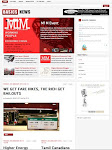 A War of Conquest Against the Afghan People
A War of Conquest Against the Afghan PeopleBASICS #16 (Nov/Dec 2009) by Steve da Silva
While the debate was playing out this past October in the American media about the planned “surge” of as many as 45,000 more American troops into Afghanistan, reports were surfacing that certain NATO members – namely, Canada, Italy, and Germany – were paying off Taleban elements in exchange for peace in the areas that they patrol.
For his part, Afghan President Hamid Karzai has said that he would reach out to the Taleban if they would agree to respect the Afghan constitution, which is double-speak for respect the occupation.
As the occupiers prepare for a massive escalation of the war, the attempts at reconciliation with certain Taleban elements once again demolishes the propagated myth that fighting the Taleban is the main object of the NATO occupation. The strategy of reaching out to so-called “moderates” is intended to isolate those elements dead-set fighting the occupation – a demand supported by a growing proportion of the Afghan population.
As the Commander of the Canadian Forces in Afghanistan, Lt. Col. Joe Paul recently said, “It’s not true that all of those people shooting at us are insurgents.” That might have something to do with the fact that not everyone NATO is shooting at are “insurgents.”
Over 1600 Afghan civilians were killed between January and August 2009 alone. On September 5, a joint American-German aerial bombing in the Kunduz province left 60-70 children and other civilians dead. In the middle of the night, many children and other civilians had rallied around two tankers stuck in the sand of a shallow river. They were filling their jerrycans with fuel when the two five-hundred pound bombs turned the trucks into twin fireballs, engulfing the civilians in an inferno.
Everyday, the occupation of Afghanistan reveals itself more and more to be a war of conquest. The widely-publicized electoral fraud in Afghanistan’s presidential elections is just one of its signs. On November 2, Karzai was declared the winner of the “election” after his only challenger Abdullah Abdullah – previous Minister of Foreign Affairs in the Karzai government - stepped down from participating in the run-off. Genuine democracy under occupation is impossible and the colonial Islamic Republic of Afghanistan has made that point very clear by putting back into power the man so widely hated by Afghans.
It was the Karzai government that put into effect for a period of time a law that legalized the rape of women within marriage. This law demonstrated to the world that the principle threat to women today stems from the foreign occupiers and the thoroughly reactionary class alliance they have cobbled together to run the colonial government in Afghanistan. The league of organized criminals, landlords, warlords, and theocrats who administer Afghanistan are not in contradiction with today’s occupation, but rely on it to stay in power in exchange for defending the occupation.
The goal of the U.S.-NATO occupation of Afghanistan is to capture geo-strategic control of the region by encircling its challengers to the east, Russia and China, and safeguarding the region for the future Trans-Afghanistan Pipeline that will transport natural gas from Turkmenistan through Afghanistan and into Pakistan and India. To the extent that the Taleban is a military concern of NATO is only the extent to which Taleban leaders fail to get in line with the occupation. The Taleban, or parts thereof, may soon come to accept the occupation, but the people of Afghanistan will not.
As the occupation intensifies its effort to crush any resistance in the coming months, with the planned “surge”, Afghan civilians will bear the greatest brunt of the violence.
If it seems like the lines between what is Taleban and what is insurgent is blurred, it is because the occupiers would have us believe that resistance to occupation is equal to extremism and religious fundamentalism, as if the aversion to foreign domination was not a fundamental human instinct. Just as the Ethiopians in the 1930s, the French in the 1940s, the Koreans in the 1950s, and the Vietnamese in the 1960s did not need Islam to teach them about the evils of foreign occupation, neither do the Afghans.
Canada has 2800 soldiers in Afghanistan and the Canadian Forces have played a leading role in combat operations, which accounts for Canada having the highest fatality rate of all the occupying forces. Over 25,000 Canadians have participated in at least one tour of occupation in Afghanistan since 2001. If the horrors of this war were not enough to repulse Canadians, then perhaps the economic argument needs to be underscored once again: The working-class, and even middle-class Canadians, have nothing to gain and much to lose from the war in Afghanistan.
On the other hand, Canada’s monopoly-capitalist ruling class has everything to gain: Access to cheap resources, desperate labour pools, military and construction contracts, geo-political world domination… These are the same monopolies that workers are fighting right here on Canadian soil. The fight for the freedom of Afghanistan is not independent of the fight for workers power in Canada.


.jpg)







